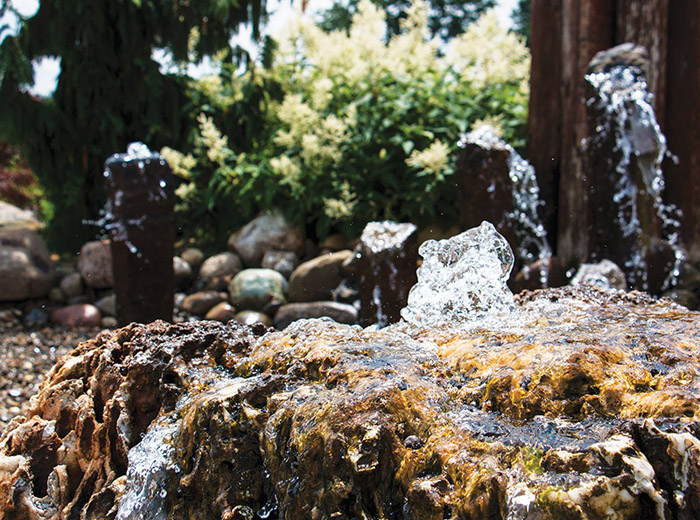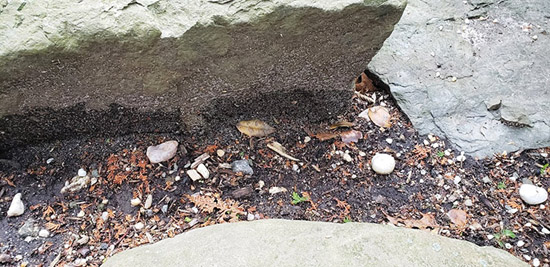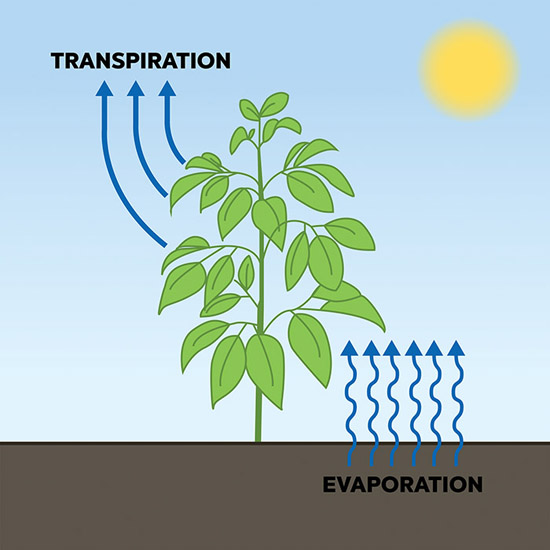
One of the more confusing issues that pond owners and contractors have to deal with is water loss in what is designed to be a closed system. Even if you’re sure that there are no leaks in your recirculating pond or fountain, the water level can still drop.
How is That Possible?
Well, the answer is that no outdoor water feature is really fully “closed” at all. Natural processes guarantee that water will be lost or consumed whatever the weather, and water loss only increases during hot or dry spells. In planted features, the plants themselves take in a lot of water through their roots, breathing out almost as much as they take in. Marginals and many terrestrial plants thrive in the wet edges of streams. A little constant splash can be just what a mossy boulder needs to stay lush and luxuriant.
But all these natural processes consume water and drop water levels, just like a leak would. So, how do you tell when water loss crosses the line between what is to be expected, and what needs to be repaired? This is especially important when a final payment might depend on which side of that line your work lands on. Although you may try to explain that some water will disappear even with no leaks, concerned homeowners will often ask you to prove it.
There are four main ways that water leaves a pond, pondless feature or fountain, no matter what you do. Before checking for conventional leaks in the liner, plumbing or equipment, consider the following: Wicking, Evaporation, Transpiration and Splash, or W.E.T.S., for short.
Wicking
Wicking, where water is drawn out of the feature by absorbent materials like wood, soil, mulch, underlayment and even waterfall foam touching the water, is one of the first processes we explain to our pond and pondless feature customers. If you want your work to emulate nature with soft edges and plants right down to the water, wicking is going to happen. I don’t usually consider this a leak unless it’s severe and unsightly. In fact, some of the best and most attractive edge treatments I’ve developed depend on a certain amount of wicking, especially to help marginals like Lysimachia (Moneywort) thrive.

Checking for wicking depends on the weather — you’ll never find a wet spot in the rain. However, after a couple of dry sunny days, you may find damp or wet areas along the pond or stream edge. The plants may look a little different in those spots (usually better for the extra water, but sometimes worse), or weeds may be thriving, or moss is growing in full sun. If it looks good, I leave it alone. If, on the other hand, there’s standing water or really saturated soil, it’s not doing the feature any good. Usually the cause of excessive wicking is a flap of underlayment or a blob of foam that oozed over the liner before setting. I’ll trim that back above the water line. If there’s a damp spot that doesn’t look too bad, I’ll usually plant a moisture-loving perennial in that spot to take advantage of it. Lemons to lemonade!
It’s difficult to estimate how much water is wicked away in natural-looking features, but you can demonstrate it by sticking a twist of underlayment into a full bucket of water and letting it trail on the ground outside the bucket. Explain this often-beneficial process to your customer beforehand and let them know that some topping off will be necessary to keep their feature looking as lush and natural as possible. As you might imagine, wicking is less often a factor in fountains and hardscape features with hard edges and few plantings.

Evaporation
The next culprit implicated in water losses is evaporation, which, unlike wicking, is often a significant factor in low-volume fountains and hardscape features. Direct sunlight, air temperature, water temperature, humidity, wind, splash and even wave action can affect or increase evaporation losses. I get a lot of questions about how to estimate losses due to evaporation.
Fortunately, there’s a fast and dirty way to roughly measure evaporation losses in ponds and fountains. Set a tub with the largest surface area you can handle in an exposed location near the water feature. Fill it to the very top so that there’s no protective rim around the exposed water surface to shadow the surface or block the breeze. If the water in the feature is in motion, simulate that motion with a small pump in the tub. Check that the water temperatures of the tub and feature are pretty close, and then measure the water loss in the tub over a couple of rainless days. The water should drop at pretty much the same rate in the tub as it does in the water feature, if all conditions are pretty close to equal. Bear in mind, the smaller volume of the tub may heat up to a higher temperature, which might skew the results. On the other hand, the rim of the tub may protect the water somewhat against wind losses as the level drops. In practice, things seem to even out.
The ratio of the drop in water level to surface area should give you an idea of what to expect, at least during that period. As the weather warms or cools and humidity levels rise or fall, the evaporation rates will change, but they will change for both the tub and the water feature, so you’ll soon be able to predict evaporative losses year round.

Transpiration
Believe it or not, plants can account for significant water loss in planted features. Although I couldn’t find many studies on the specific amount of water transpired or, literally, “breathed through” by water plants, consider the following facts.
Of all the water absorbed by plants, less than 5% remains in the plant for growth. The vastly greater part is exhaled as water vapor through pores (stomata) on the underside of leaves. Few marginal plants have been examined, although horsetail (Equisetum) is sometimes cited as an example of low transpiration because it has no leaves. Corn, on the other hand, is an important crop and a common research subject. Studies show that a corn plant transpires 99% of all the water it absorbs during its lifetime.
Water plants probably transpire profusely also, because of how water loss is controlled. Most plants minimize water loss by closing their stomata when humidity is low. In the high humidity environment around a pond or stream, plants will be able to keep their pores wide open, so marginals and aquatics probably shed water vapor profusely through their pores.
Want proof? Construct a simple potometer to, literally, “measure what is drunk.” Put a bare-root marginal in a bucket of water and mark the water level in the morning. Check the water level that evening to figure daily water loss per plant per day. (Don’t worry about overnight losses, as they will probably be negligible.
Transpiration losses occur mainly during hours of active photosynthesis when stomata are open to allow carbon dioxide in; most plants close their stomata at night.) Whatever the specific amount may be, expect greater water losses due to transpiration in heavily planted ponds.
Splash
Any time water is in motion, you should be on the lookout for splash. Any wet spots outside the pond on stone, gravel, paving, vegetation, soil or mulch are lost water. I guesstimate the total loss by finding a wet spot where there’s visible splash, like outside the liner or on hot rocks, and I set a paper towel on it. You may have to put something under the paper towel or shade it to keep the water from evaporating.

Assess how much water has been absorbed by the paper towel over a given time period. If there’s a lot of water, squeeze it out into a 1-ounce sauce container like you find at fast food places, or weigh the paper towel to find the quantity of water using 1 gram = 1 milliliter, and then estimate the total quantity of paper towels you’d need to capture all the splash. When I do the math, I am always surprised at what it adds up to over a 24-hour period.
Other Resources
A quick way to gauge what a water feature should be losing due to the combined effects of evaporation and transpiration can be gleaned from resources like the National Regional Climate Center at Cornell University (www.nrcc.cornell.edu). These monthly average Potential Evapotranspiration (PET) estimates are the theoretical maximum evapotranspiration possible off an unlimited supply of water, such as a lake, or one of our water features that we will not allow to run dry. When I look at the highlighted PET values at LaGuardia Airport on Long Island, where I live, I see I can expect to lose 4.41 inches in the month of July, or about 1 inch a week, just due to evaporation and transpiration alone. Once you add in wicking and splash, an average water loss of only a couple of inches a week is probably a guarantee that there is no leak at all.
So, before you start looking for the elusive leak that’s causing that ¼-inch-a-day drop that your customer is so concerned about, check for W.E.T.S. spots — and reassure them that it’s only natural!


